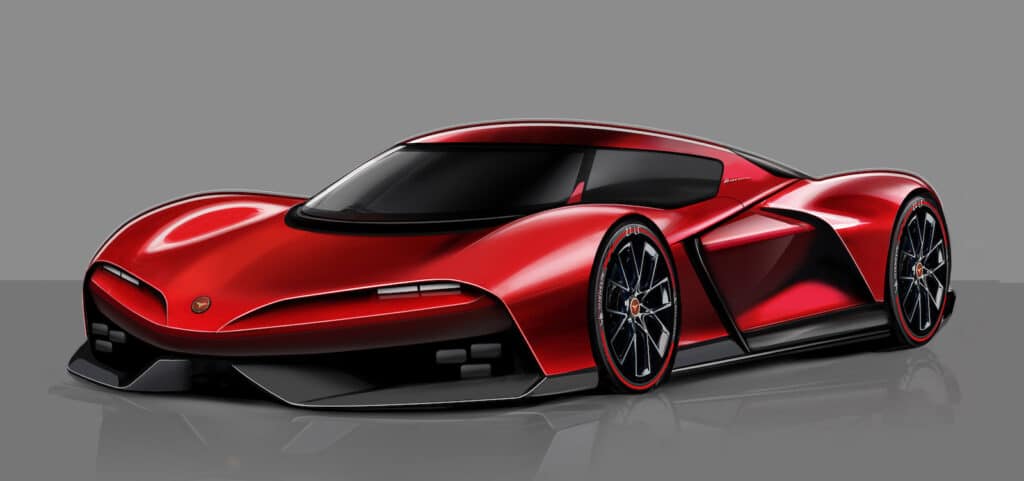
Resuscitated Italian automaker Bizzarrini is following up last year’s 5300 GT Revival with the all-new Giotto, named after company founder, Giotto Bizzarrini. The limited run hypercar is designed by Giorgetto Giugiaro, who also worked on the first Bizzarrini, the 5300 GT.
Created with help from Giotto Bizzarrini’s son, Fabrizio, the new car’s body will be built using carbon fiber and lightweight composite along with design cues Bizzarrinis are known for, including dual hood-mounted vents.
“To have the opportunity to design an entirely new car from Bizzarrini is a privilege,” Giugiaro said, in a statement. “With the Giotto, we honor the past, but we focus wholly on the future.”
Another new beginning
While the company didn’t release any specifications for the new car, the automaker did say that a naturally aspirated V-12 engine is planned, paired to an 8-speed dual-clutch transmission. The project is being overseen by Bizzarrini Chief Technical Officer Chris Porritt, who oversaw engineering at Aston Martin, Tesla and Rimac.

“We have a very clear vision for the Giotto, defined ultimately by how it makes a driver feel. Bizzarrini is a brand built on genius and passion, established by a polymath with world-class talents as a designer, engineer and test driver. We now very deliberately and authentically recreate Giotto’s vision,” Porritt said.
Testing of the prototypes won’t begin until 2024, although more details about the hypercars should become available later this year.
The Bizzarrini brand was re-established in 2020 by Aston Martin’s former CEO Ulrich Bez with backing from Adeem Investments, which helped finance the buyout of Aston Martin from Ford Motor Co. in 2007.
The first vehicle issued by the company, the 5300 GT Revival, is powered by a 5.3-liter V-8 that produces more than 400 horsepower and 387 pound-feet of torque, more than enough to provide the 2,755-pound sports car with impressive acceleration.
“The 5300 GT Corsa Revival was an introduction to the world of the genius of Bizzarrini, but the Giotto is the centerpiece of our future as an exclusive supercar manufacturer. It forms the heart of a ten-year strategy that will see additional variants,” said Ian Fenton, the company’s current CEO.
Giotto Bizzarrini’s legacy

Born into a wealthy family in Livorno, Italy, Giotto Bizzarrini studied engineering in Pisa before landing a job at Alfa Romeo, where he helped develop the Giulietta’s chassis, before joining the experimental department and spending time as a test driver.
In 1957, Bizzarrini joined Ferrari, where stayed through 1961, where he was best known for his involvement with the iconic 250 GTO. Yet he left in 1962, one of four Ferrari employees who walked out in protest during the “Night of the Long Knives,” a dispute over Laura Garello, Enzo’s wife, whose increased involvement in company affairs created internal tensions that led to the walkout. They never returned.
Bizzarrini went on to establish Società Autostar in 1962, creating the V-12 engine that would power the Lamborghini 350 GT, Miura, Countach, Diablo and Murcielago. Bizzarrini also worked with Iso Automotoveicoli in developing the chassis, suspension and brakes for the company’s Rivolta and Grifo models that same year. After competing in the 12 Hours of Sebring throughout the 1964 season, and taking first place in their class at the 24 Hours of Le Mans, his Iso Grifo vehicles became legendary.
The first new beginning

The big change arrived in 1964, when Bizzarrini went off on his own. The first of Bizzarrini’s self-branded cars was built using the aluminum-bodied Iso A3/C race car and dubbed the Bizzarrini GT 5300 Strada.
Powered by a 365-horsepower Corvette V-8 engine and a 4-speed manual transmission, it was a true sports car. It sat very low, lacked creature comforts and possessed an incredibly cramped cabin. Many employed aluminum bodies, although some were built from fiberglass. Other models followed, including the 1900 GT Europa and P538S before Bizzarrini filed for bankruptcy in 1969.
Remarkably, Giotto Bizzarrini is still alive at 96 years old, but is not associated with the brand’s revival. Nevertheless, executives are confident of the revived marque’s success.
“We have created something that is both recognizably Bizzarrini and totally relevant for an entirely new era of this cherished Italian brand,” Giugiaro said.
Bizzarrini isn’t the only automaker being brought back from the dead. The move to revive moribund brands has accelerated in recent years, as new life is being given to such makes as Delage and Hispano Suiza.
- SEO Powered Content & PR Distribution. Get Amplified Today.
- Platoblockchain. Web3 Metaverse Intelligence. Knowledge Amplified. Access Here.
- Source: https://www.thedetroitbureau.com/2023/02/a-revived-bizzarrini-announces-v-12-hypercar/



